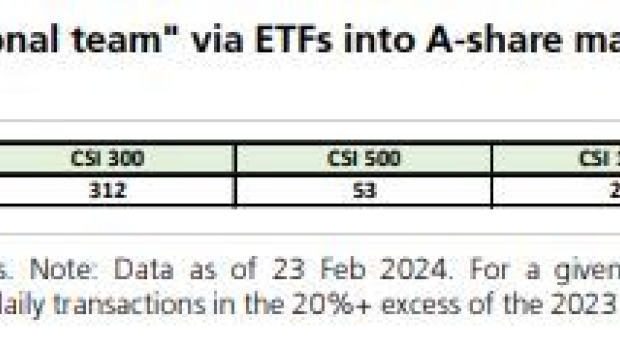Feb 26, 2024
China’s National Team Bought $57 Billion of Shares, UBS Says
, Bloomberg News

(Bloomberg) -- China’s state-backed funds have poured more than 410 billion yuan ($57 billion) into onshore shares this year in a bid to prop up the market, according to estimates by UBS Group AG, which expects further purchases.
The Swiss bank based its calculations on “excess” transactions of 54 Chinese exchange-traded funds. More than 75% of the inflows went into products tracking the benchmark CSI 300 Index while another 13% flowed to those mirroring the CSI 500 Index, according to strategists including Lei Meng.
State funds have been key to stabilizing the latest stock rout, with Central Huijin Investment Ltd. saying earlier this month that it will continue to increase its ETF holdings. A flurry of trading volume spikes across a number of ETFs suggest authorities have been actively buying both blue-chip and small-cap stocks.
Source: Wind, UBS-S estimates. NOTE: Data as of Feb. 23. For a given ETF, the amount of “excess transactions” is the amount of daily transactions in the 20%+ excess of the 2023 daily average amount.
UBS strategists said the national team added 1.24 trillion yuan of shares over July to September 2015, when the stock market was tanking. The current year-to-date flow of 410 billion yuan is “well below the historical level, with the potential to rise further under extreme conditions,” they wrote.
Read: BofA Says State Funds Drive Biggest-Ever China Stock Inflows
“We like the China domestic market more than the offshore market because the domestic market has policy support with evidence of national team buying,” Sunil Koul, Asia Pacific equity strategist at Goldman Sachs Group Inc., said on Bloomberg TV.
The CSI 300 gauge has risen more than 7% this month while an index of Chinese shares trading in Hong Kong has climbed more than 10%. Some investors see further upside potential thanks to depressed valuations and light positioning among money managers.
In addition to the national team’s rescue efforts, Beijing has introduced a slew of measures to support the market and the economy, including tighter scrutiny on quant trading and funding support for developers.
(Updates with comments from Goldman Sachs.)
©2024 Bloomberg L.P.





